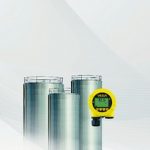Firmen im Artikel
The term IIoT (Industrial Internet of Things) refers to networked machines or production facilities, including the associated measurement technology. Among its most important benefits are the prospect of being able to react faster to inefficient processes or problems, save time and use smart machine data to enable more efficient control of production and operating processes as well as entire value chains. All this should be possible in nearly real time, with the help of intelligent monitoring and decision-making processes. That’s the theory, but what does the actual implementation look like – from the perspective of a field instrument manufacturer like Vega?
Using the wheel in a new way
When it comes to measuring and monitoring level and pressure, Vega is ready to meet the individual requirements of the process industry. “We are consistently modular. This is a big advantage because it means we can get started at any time”, explains product manager Stefan Kaspar. “We don’t have to reinvent the wheel to meet our customers’ newest requirements.” Vega relies on bridging technologies such as Bluetooth. These are future-oriented, scalable solutions that can be integrated into existing systems. They can also provide new systems with a tailor-made basic security configuration that continues to grow with new capabilities. “It’s important”, says Kaspar, “that users do not have to invest large sums upfront and that the solution can be seamlessly integrated into their existing set-up without compromising security”.
Vega has a comprehensive range of Bluetooth technology covering almost its entire sensor portfolio on the basis of a well thought-out, multi-level concept. The company wants to react flexibly to different security requirements in this way. Plicscom, the universal display and adjustment module, is accordingly available either with or without Bluetooth. In the Bluetooth version, this function can be switched on or off at any time by means of a hardware switch. When used with multiple sensors, the wireless function is optional. Bluetooth is already securely encrypted at the interface level via a PC, laptop, smartphone or tablet. What’s more, sensor access via Bluetooth requires an access code. Wireless technology can also be applied to older devices: Plicscom is backward compatible for the majority of Vega sensors already in the field – as far back as 2002.
Secure through a second data channel
Plicscom, the display and adjustment module, is a convenient and economical solution wherever existing systems – which usually only have analogue 4 to 20 mA interfaces – need to be upgraded to digital, step by step in a sustainable fashion. Kaspar is keen to emphasise that “the range meets the Namur requirements for open architecture”. The association demands that the IT components be quickly and flexibly integrated, since they are generally shorter-lived than the industrial process components. This is vital if process engineering is to keep pace with the 4.0 development. “This is the starting point for Vega’s initiatives: optimal system availability, security and lean solutions that can be easily upgraded if required”.
Bluetooth offers a form of communication that runs via a separate, second data channel, making it independent of the user channel. Field devices can thus be analysed parallel to the existing process control without interfering with plant security and availability. In the future, this local Bluetooth communication will be expandable to a complete diagnostic network, allowing diagnostic access from the control room down to the field level, also for existing analogue field devices from Vega. Plant operators will then be able to react to errors faster and in a more targeted manner, and detect deviations in the process early by recording the extensive information which is available in the field device and taking appropriate countermeasures.
No more empty bins
Just as flexible in use, although a big step ahead in terms of digital intelligence, is the Vega Inventory System. It offers seamless status monitoring, providing (or potentially providing) a database for efficient process supply and automatic re-ordering. The functions of the Vega Inventory System always follow the application. Should the supplier be notified automatically as soon as minimum stock levels are reached? Is the system “only” meant to visualise the course of production cycles reliably across different periods, locations and media in order to provide the user with a basis for further action? Should it “simply” shorten supply chains to remote bins and allow query data to be utilised over long distances? Or is it instead about integrating inventory directly into an ERP system? The options and possibilities are many and varied, and they can be added to at any time. The free choice of network host is an advantage for security. This task can either be carried out locally by the users themselves or transferred to the protected, always up-to-date Vega cloud. “We want to make life easier for our customers, which is why our measuring instruments function according to the principle of simplicity”, Kaspar continues. The Vega Inventory System stands for minimum effort and maximum compatibility – with modularity a top priority.
Future standard
It is anything but easy to network field devices via digital fieldbuses, such as Profibus PA or Foundation Fieldbus, and then make the analysis and evaluation data available to the control level. Several decades after they were first introduced, these technologies have still not succeeded in replacing the analogue 4 to 20 mA process signal as the most widely used interface for level and pressure measurement technology due to their high complexity and costs. Bluetooth is a bridging technology that points in the right direction within this gap. It mediates between the analogue current interface of a field device and the Ethernet-based IT networks that are standard at almost all companies today. But why have field devices in the process industry not yet been upgraded for direct connection to the existing IT infrastructure, for example with an Ethernet interface? The existing two-wire technology, based on the 4 to 20 mA interface, has a decisive point in its favour here: the measured value and supply voltage can be provided simultaneously via just two wires. In addition, they conform to the “intrinsically safe” type of protection and are also explosion-proof for use in hazardous areas.
The new Advanced Physical Layer (APL) makes a good alternative. Based on industrial Ethernet technology, this intrinsically safe, two-wire Ethernet communication standard will in future be able to handle demanding applications in process automation. The idea is to design it for a range of up to 200 m and a bandwidth of 10 Mbit/s – including the power supply. Eleven well-known industry partners are currently involved under the umbrella of Profibus International, with Vega as well as the FieldComm and ODVA organisations among them. Their common goal is to eliminate the communication bottleneck between field devices and the control level. Even if several years elapse before the first APL devices become available in the market, if it is possible to radically simplify the set-up and administration of such networks, this technology has the potential to become the future standard for process automation.
Online search: cpp0119vega













